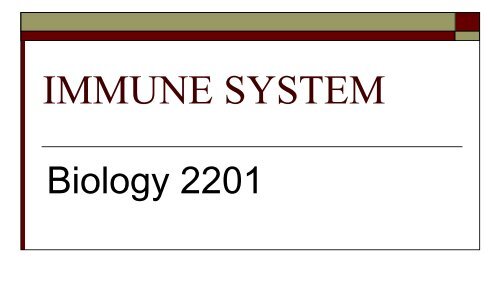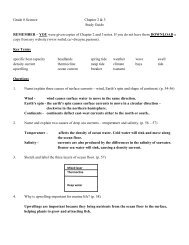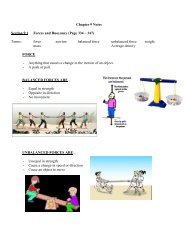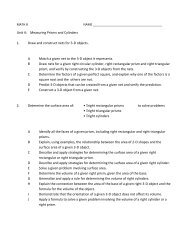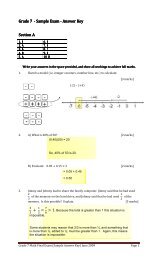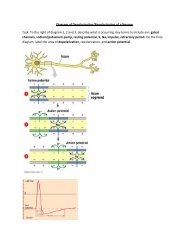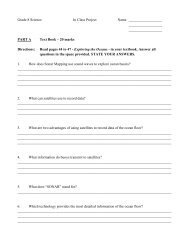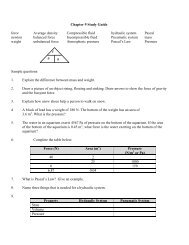Biology 2201 Chapter 11 Immunity pdf.pdf
Biology 2201 Chapter 11 Immunity pdf.pdf
Biology 2201 Chapter 11 Immunity pdf.pdf
Create successful ePaper yourself
Turn your PDF publications into a flip-book with our unique Google optimized e-Paper software.
IMMUNE SYSTEM<br />
<strong>Biology</strong> <strong>2201</strong>
What is a disease?<br />
<br />
Other than an<br />
injury, any change<br />
in the body that<br />
interferes with the<br />
normal functioning<br />
of the body.
Two Types of Diseases<br />
<br />
Non-infectious<br />
• often called functional<br />
diseases,<br />
• Caused when an organ<br />
does not function<br />
properly anymore<br />
• Examples:<br />
<br />
cancer, heart disease<br />
<br />
Infectious<br />
• Caused by a pathogen or<br />
disease-causing agent<br />
<br />
Viruses, bacteria, fungi,<br />
prions<br />
• Are often contagious<br />
• Examples:<br />
<br />
Influenza, measles,<br />
AIDS, STI’s
Non-specific Defenses<br />
<br />
<br />
<br />
These are your first line of defense against<br />
pathogens.<br />
They guard against all foreign organisms and<br />
not just any one specific organism.<br />
Two types of non-specific defenses:<br />
• Chemical barriers & physical barriers<br />
• Inflammatory response
Physical and Chemical Barriers<br />
<br />
<br />
Physical Defenses<br />
• skin<br />
• membrane linings<br />
• Cilia<br />
Chemical Defenses<br />
• Sweat and oils<br />
• saliva<br />
• stomach acid<br />
• urine<br />
• tears<br />
• Mucus<br />
• Interferons *
Inflammatory Response<br />
<br />
<br />
<br />
<br />
<br />
It is a reaction that causes redness, swelling, pain, and warmth in<br />
the area of infection.<br />
Cells damaged by the infection release chemicals, that causes an<br />
increase in blood flow to the infected area.<br />
This results in white blood cells called phagocytes being<br />
transported to the site of the infection.<br />
The phagocytes ingest the pathogens and damaged tissue, resulting<br />
in the formation of puss.<br />
This usually kills the pathogen, but sometimes the infection gets to<br />
the lymphatic system and causes the lymph nodes to swell.
Inflammatory Response<br />
<br />
<br />
<br />
If the infection is serious, it results in the formation of more<br />
phagocytes.<br />
If this does not finish the infection, chemicals are released<br />
that increase the body temperature causing a fever.<br />
A fever serves two major purposes:<br />
• kills microorganisms that cannot survive the higher temperature<br />
• slows down microorganisms, giving the white blood cells a<br />
chance to destroy them<br />
http://faculty.riohondo.edu/rbethel/videos/micro_inflammation.swf
Interferons<br />
<br />
<br />
<br />
Recall that viruses infect host cells by taking<br />
over their metabolic and reproductive functions<br />
in order to replicate virus particles<br />
Interferons are substances produced by cells that<br />
have been infected by a virus.<br />
It causes non-infected cells to produce an<br />
enzyme that blocks reproduction of the virus.<br />
• This slows the replication of the virus
Non-Specific vs. Specific Defenses
Specific Defenses<br />
<br />
<br />
<br />
If the pathogen gets past the nonspecific<br />
defenses, it will encounter the<br />
specific defenses.<br />
At this stage the immune system begins<br />
to work<br />
It provides the body with the ability to<br />
fight infection through the production of<br />
antibodies or cells that inactivate<br />
foreign substances or cells.
Ready, Aim, FIRE!<br />
<br />
<br />
<br />
The immune system includes all parts of the<br />
body that are involved in the recognition and<br />
destruction of foreign materials<br />
The basis of immunity lies in the body’s ability<br />
to distinguish between its own substances (self)<br />
and foreign substances (non-self)<br />
Any foreign substance that triggers a specific<br />
defense response is called an antigen
All about antigens<br />
<br />
<br />
<br />
Usually protein, but can be carbohydrates,<br />
lipids or nucleic acids located on the<br />
surface of bacteria, viruses and other<br />
pathogens<br />
Antigens trigger a response against foreign<br />
substances identified as non-self<br />
The response to an antigen is called an<br />
immune response
Types of <strong>Immunity</strong><br />
Active <strong>Immunity</strong><br />
The body produces its own<br />
antibodies to attack a specific<br />
<br />
<br />
antigen.<br />
Long lasting<br />
It develops in two ways:<br />
• when a person had the disease<br />
• by vaccination of a weakened<br />
or milder form of the<br />
pathogen<br />
Passive <strong>Immunity</strong><br />
<br />
<br />
This is “borrowed” immunity<br />
The person is given<br />
antibodies from another<br />
person or animal who has<br />
been infected by the antigen.<br />
Temporary, lasting only 30<br />
days, but faster acting then<br />
the active immunity response
Immune System and Transplants<br />
<br />
<br />
<br />
<br />
The immune response can result in<br />
problems with organ transplants.<br />
The body recognizes transplanted<br />
organs as foreign (non-self), and tries to<br />
fight them as if they were a pathogen.<br />
The result would be the destruction of<br />
the transplanted organ.<br />
This is controlled in two ways:<br />
• Donor and recipient are closely<br />
matched<br />
• Recipient is given drugs to suppress<br />
the immune system
Two Categories of Immune Response<br />
T Cell Reaction vs. B Cell Reaction
Types of Immune Responses<br />
Primary Immune Response<br />
This occurs when an antigen<br />
enters the body for the first<br />
<br />
<br />
<br />
time.<br />
It takes 5 days for the body to<br />
recognize the antigen and<br />
start production of antibodies.<br />
It takes another 10 to 15 days<br />
for the antibodies to build up.<br />
Most likely will get sick for a<br />
time<br />
Secondary Immune Response<br />
This occurs if an antigen that<br />
has entered the body before<br />
• Same pathogen enters a<br />
second time.<br />
<br />
<br />
There is a shorter response<br />
time of only 1 to 2 days for<br />
antibody production<br />
May or may not get sick<br />
depending on the pathogen
AIDS – Acquired Immune Deficiency Syndrome<br />
<br />
The cause of AIDS is a virus<br />
called the human<br />
immunodeficiency virus – HIV<br />
<br />
<br />
The virus attacks the helper T<br />
cells of the immune system.<br />
The virus enters the T cell and<br />
remains within the cells for<br />
months or even years without<br />
producing symptoms
AIDS’ Disturbing Properties<br />
<br />
<br />
It is able to mutate giving it the ability to produce<br />
different strains.<br />
• HIV-1;1981, HIV-2; 1985<br />
• Dozens of subtypes worldwide for each strain<br />
It causes change in the cell membrane of the T cell<br />
causing them to fuse together.<br />
• This allows the virus to pass from cell to cell without<br />
entering the bloodstream and becoming exposed to<br />
antibodies present in the blood
What’s more?<br />
<br />
<br />
<br />
When HIV becomes active, the individual develops AIDS. The<br />
virus reproduces, spreads, and destroys helper T cells. The T cells<br />
become a HIV factory.<br />
Some possible triggers for HIV activation are:<br />
• other co-infections<br />
• contain a gene like a ticking time bomb<br />
The decrease in helper T cells weakens the immune system. The<br />
body loses its ability to fight disease and becomes susceptible to<br />
opportunistic infections and malignancies
Spread of AIDS<br />
<br />
<br />
<br />
<br />
Sexually transmitted<br />
Blood-to-blood contact<br />
Mother to fetus during<br />
pregnancy or at the time of<br />
birth<br />
In rare cases through breast<br />
milk
Prevention of AIDS<br />
<br />
<br />
<br />
Abstinence from sexual<br />
activity<br />
Use of a latex condom,<br />
plus spermicide<br />
nonoxynol-9<br />
Avoid sharing of needles<br />
during of intravenous<br />
drug use


